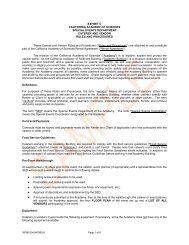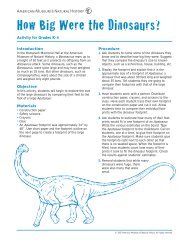Annual Report 2004–2005 - California Academy of Sciences
Annual Report 2004–2005 - California Academy of Sciences
Annual Report 2004–2005 - California Academy of Sciences
Create successful ePaper yourself
Turn your PDF publications into a flip-book with our unique Google optimized e-Paper software.
EXPLORE<br />
Research informs all <strong>Academy</strong> pursuits, from exhibits to educational programming,<br />
and each year our staff pursue projects all over the world, assessing biodiversity<br />
in threatened regions, advocating for the protection <strong>of</strong> endangered species,<br />
and training the next generation <strong>of</strong> scientists.<br />
The Gaoligongshan Biodiversity Survey<br />
In 2002, the <strong>Academy</strong> launched the Gaoligongshan Biodiversity<br />
Survey, a large-scale inventory <strong>of</strong> the Gaoligongshan<br />
region <strong>of</strong> the Yunnan Province <strong>of</strong> China. In partnership<br />
with the Chinese <strong>Academy</strong> <strong>of</strong> <strong>Sciences</strong> and Ministry <strong>of</strong><br />
Forestry, <strong>Academy</strong> staff conduct research while generating<br />
extensive natural history collections, fostering training and<br />
intellectual exchange programs among participating institutions,<br />
and making detailed information available to the local<br />
population and government agencies to aid land-use decisions.<br />
The project will continue over the next three years<br />
with a $225,000 grant from the John D. and Catherine T.<br />
MacArthur Foundation.<br />
Return to the Galápagos Islands<br />
In spring 2005, led by <strong>Academy</strong> scientists Meg Burke, Tom<br />
Daniel, Terry Gosliner, and John McCosker, 33 <strong>Academy</strong><br />
members and Trustees embarked on a two-week trip to<br />
commemorate the 100th anniversary <strong>of</strong> the <strong>Academy</strong>’s<br />
first research trip to the Galápagos Islands. The original<br />
voyage lasted more than a year and produced specimens<br />
that helped rebuild <strong>Academy</strong> collections after the 1906<br />
earthquake. Since this initial historic trip, <strong>Academy</strong> scientists<br />
have returned to the Galápagos Islands many times<br />
to collect specimens and help found the Charles Darwin<br />
Research Station at <strong>Academy</strong> Bay and the Galápagos National<br />
Park.<br />
On this most recent trip, <strong>Academy</strong> travelers visited many <strong>of</strong><br />
the collection sites from the first voyage and even received<br />
permission to visit usually <strong>of</strong>f-limit areas, such as the island<br />
<strong>of</strong> Marchena. Our deep ties to these islands were strengthened<br />
in a reception at the presidential palace in Quito,<br />
Ecuador and the signing <strong>of</strong> a formal partnership between<br />
the <strong>Academy</strong> and the government <strong>of</strong> Ecuador to continue<br />
to explore the Galápagos, train young scientists, and develop<br />
educational programming for the public. As part <strong>of</strong><br />
the partnership, over the next several years, Ecuadorian<br />
students and scientists will visit the <strong>Academy</strong> to work collaboratively<br />
with our research and education staff.<br />
Training Tomorrow’s Scientists<br />
Each summer, the <strong>Academy</strong> Research Division <strong>of</strong>fers internships<br />
in the Summer Systematics Institute (SSI). This past<br />
year, nine undergraduates from around the country participated<br />
in another successful SSI program aimed at training<br />
the next generation <strong>of</strong> phylogenetic systematists. Interns<br />
conducted individual research projects and the program<br />
culminated with presentations on sand dollar evolution,<br />
frogs from Myanmar and Sao Tomé, and techniques for<br />
illustrating turtles and corals.<br />
4


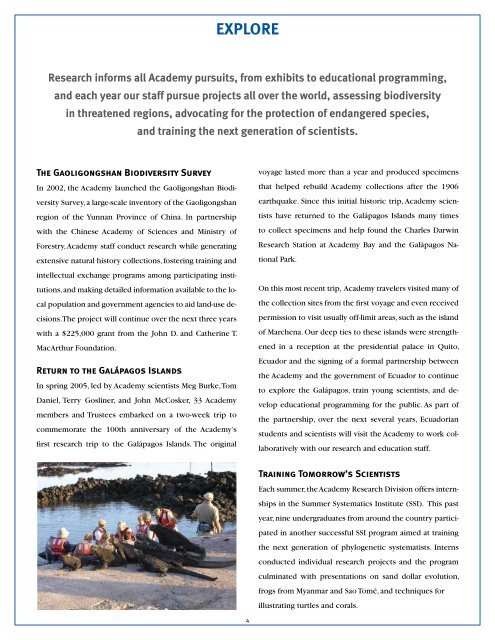
![download [PDF - 2.7mb] - California Academy of Sciences](https://img.yumpu.com/26596748/1/190x122/download-pdf-27mb-california-academy-of-sciences.jpg?quality=85)

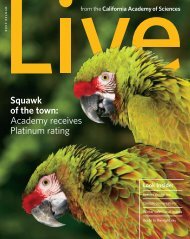

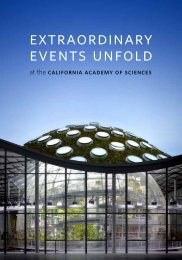

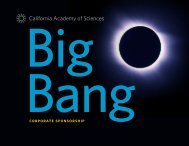
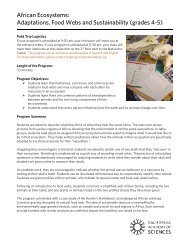
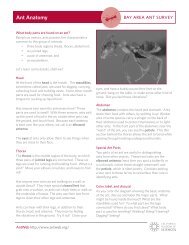
![Download a visitor map [418k] - California Academy of Sciences](https://img.yumpu.com/26596645/1/190x88/download-a-visitor-map-418k-california-academy-of-sciences.jpg?quality=85)
